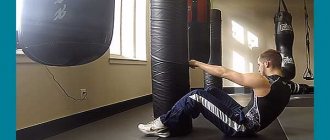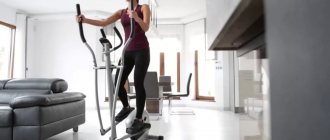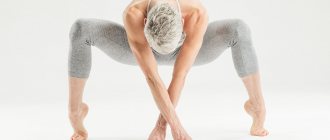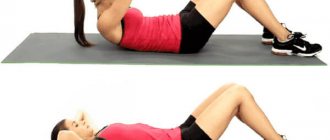Have you ever wondered why only a few of the great number of athletes can boast of washboard abs? But it would seem that training the press is a simple matter: lie down on the floor and go ahead - the more repetitions, the better! Meanwhile, in fact, these endless fidgeting on the floor are more likely to lead to calluses in the nth place than to pump up quality abs.
A real “reinforced concrete” press is the result of a completely different methodological approach, little known among fans of iron sports.
How many reps should you do?
Give up all your dreams of toned abs if you do more than 15 reps in one set. This scheme is ineffective. You will ask why? It's simple. Do you know what fast and slow muscle fibers are? So, your press consists mainly of the former. This means that, due to physiological characteristics, he will respond better to heavy low-repetition sets. While a light load, but a large number of repetitions, will make your muscles “shrink” like those of marathon runners.
For beginners, 15 repetitions is the maximum. Advanced ones should train the abs by adding loads and reducing the number of repetitions down to 6-8 and even 4. The recommended “crunches” for 15 minutes at a time are in the realm of complete idiocy. In short, abdominal training should be the same as training other muscles - hard, intense, but not for long.
Sports supplements for the abs
Add proper nutrition and sports supplements to the suggested workouts and exercises and you will see the results soon. Amazing abs at home - it's real. Basic L-carnitine supplements and fat burners will help speed up the fat burning process. They are specially designed for fitness-active people of different fitness levels. Also useful:
| Protein isolate | It features a deep degree of purification from impurities. Contains less lactose and fat, but more pure protein. Taking isolate is recommended for those who want to lose weight. |
| Pre-workout complex | Increases productivity during sports, strength, endurance, recovery speed between approaches. |
| Vitamin-mineral complex | During intense physical activity, vitamins and minerals are consumed by the body faster. They are also responsible for protein synthesis and are the engine of metabolic processes. |
| BCAAs | Allows muscle fibers to recover faster and provides building material for the growth of lean muscle mass. |
The following supplements are recommended for the male half.
Changing the training scheme
How many times have you heard the phrase “muscles need to be worked through a full range of motion,” but this is precisely what does not happen when you do crunches on the floor or on a bench. And since the amplitude is incomplete, it is impossible to achieve full development of the abdominal muscles.
Where is the way out? It is necessary to change the traditional execution scheme: add resistance and do crunches not on a plane, but on a large ball. Its spherical shape doubles your range of motion! And abdominal training becomes twice as effective. Other abdominal exercises, such as hanging leg raises, also increase range of motion compared to horizontal crunches. True, hanging exercises are aimed mainly at the lower abs.
If you don't have the opportunity to train on a spherical ball, do crunches on an incline bench. But for beginners, it is better to start with regular crunches - on a horizontal surface, and move on to inclined ones gradually, as skills develop.
How to work your oblique muscles at home
You can perform any oblique crunches while rotating your torso. For example, pick up a heavy object and perform side bends of the body, which also quickly and effectively works the abdominal muscles - both at home and in the gym.
Side bends with dumbbells
Russian crunches and their various variations, as well as side turns, will help you quickly pump up your oblique abdominal muscles at home.
Nuances in abdominal training
Many bodybuilders, even advanced and experienced ones, stick to the same program for months. It is not surprising that their press was “mothballed.” To ensure your progress is constant, consider the following important points.
- Your athletic “foundation” (what sport did you do before bodybuilding). The more comprehensive it was, the faster your body will get used to a particular training program. For example, if you were involved in athletics in high school, your nervous system will be more likely to adapt to a certain set of exercises. That is, you will come to “stagnation” earlier than someone who, before bodybuilding, did not even know what sport was.
- Your experience in bodybuilding (how long have you been pumping iron). The longer you train with weights, the faster you will again adapt to a particular training regimen. Many experienced trainers say that beginners need to change the program every four, advanced athletes every three, and experienced athletes every two weeks.
But what kind of “change” can there be when it comes to training your abs? After all, there are just one or two abdominal exercises and I’ve missed them. Nevertheless, you can successfully diversify your complex. Break the established exercise pattern: vary the number of sets and repetitions, change the load, tempo, rest time. This will be quite enough to stir up the nervous system and give the abs an impetus for further growth.
Fitness program ABS 8 min Pump up your abs in 8 minutes. - reviews
I continue my series of reviews about programs that will help us all become slim and fit! (what happened in previous episodes can be read, for example, HERE
I already wrote about the buttocks from this wonderful trainer, now let’s turn our close attention to the abs! The concept of the video remains the same: several types of different exercises that work all the abdominal muscles, each lasting 45 seconds, and the duration of the entire lesson is 8 minutes.
So ladies, you are only 8 minutes away from getting abs.
) (and at 16 from getting rid of cellulite, if you add a video with exercises on the buttocks to this video)
The video begins, like the previous ones, with the smile of a sexy, handsome trainer)
Well, now let's move on to the actual exercises:
1. Basic crunches
. Execution time: 45 seconds.
It is aimed at working your rectus abdominis muscle.
(+ partially affects the external oblique muscle of the abdomen).
A few basic rules: 1) in the video, the trainer touches the back of the head with his fingertips. Here it is important not to clasp your hands behind your neck or on the back of your head, not to press with them, not to help yourself by pushing your head away. You just need to lightly touch the back of your head with your fingers. That's all.
Also, your head should not fall to the floor, it should be raised throughout the exercise. And don't strain your neck! She should be relaxed and you should not feel any discomfort or inconvenience.
If you feel it, then you are doing the exercises incorrectly. In this case, you are working the muscles of your neck, not your abs!
2. Oblique twists.
Execution time: 45 seconds on each leg. (only 90 seconds)
The exercises are aimed at working your oblique abdominal muscles (+
The hips work well, since you have to constantly keep your leg in the air).
Basic rules: as in the previous exercise, you only lightly fix your hand on the back of your head, do not press, do not pull, do not help. And in the same way, don’t lower your head to the floor.
Around this stage you will feel a slight burning sensation in the abdominal muscles))
3. Raises to the foot).
Execution time: 45 seconds.
In this exercise, you do not lower your head to the floor, just your shoulders a little, and stretch your palms to your shins and heels. Aimed at the rectus abdominis muscle.
Legs should be at an angle of 90 degrees!
4. Reverse crunches
. Execution time: 45 seconds.
In basic crunches, you pulled your body towards your legs, now, on the contrary, you pull your legs towards your body.
Your legs are raised and bent at an angle of 90 degrees, with springy movements you pull them as close to your stomach and yourself as possible, trying to touch your chest with your knees.
The most important thing here is to make a jerk when the legs are already raised and more or less close to the stomach, it is important to tense the rectus abdominis muscle and pull them even closer. Exactly tense and closer, and don’t just move your legs back and forth without making any effort!
5. Twisting on the right and left sides
- 45 seconds for each.
we work out the oblique muscles well
. Again, lightly touch the back of your head with your fingers, don’t help yourself with your hand, don’t lower your head to the floor.
Important: do not lower your legs to the floor either, keep them at approximately a 45-degree angle. We don’t chatter them, they are fixed and motionless.
6. Through shocks.
Execution time: 45 seconds.
Legs are bent at the knees and slightly apart, palms are crossed. Tensing the rectus abdominis muscle,
we push our crossed palms through our legs at knee level forward, and forward, and forward. Rhythmic, frequent repetitions. You should be focused on your stomach.
Relax your neck, do not lower your head to the floor!
7. Leg raises
. Execution time: 45 seconds.
My favorite! Let's finish off your rectus abdominis muscle
))
The exercise is very similar to reverse crunches, only here your legs are as straight as possible. And we stretch them as high as possible. Up and forward, straighten your toes, don’t bend your knees! And we definitely lift our butt off the ground. A sharp push and up. The higher the better.
8. Alternative crunches.
Execution time: 45 seconds.
In turn, with the left and right elbow we reach for the right and left leg, respectively! Oblique muscles are our everything)
Fast pace, rhythmic, with a smile. The sexy trainer also manages to encourage you)
9. The last 30 seconds of pain
)
Fix your palms on a point just below your solar plexus, rest your fingers and perform normal body lifts without lowering your head to the floor.
To feel the burning and pain, as the trainer says)
All! You are well done)
And now briefly about the program (again, as with exercises for the buttocks, there are only continuous advantages)
- fast
- effectively
- can be done at home
- you don't need anything other than a gymnastics mat
- sexy trainer
- strengthens your abdominal muscles
- will tighten your stomach
- just 8 minutes a day
In general, I highly recommend this complex + 8 minutes for the buttocks + light gymnastics. Bottom line: you are amazing!
Get to the point
We offer you a shock method for pumping up the abs, designed for eight weeks. The scheme of exercises, sets and repetitions, tempo of movements, rest time and frequency of training per week are presented in three options - for beginners, advanced and experienced athletes. Choose the option that suits you personally and in two months, believe me, you won’t recognize your abs. One hundred percent guarantee, like in a Swiss bank!
| Complex for beginners | |||||
| Exercises | Sets** | Repetitions*** | Tempo(sec)**** | Rest(min) | Workouts per week |
| Crunches* | 1-3 | 12-15 | 3-0-3 | 1-3 | 2 |
| Pull down with straight arms | 1-3 | 12-15 | 3-0-3 | 1-3 | 1 |
*/ Start with crunches on a horizontal surface. When you can do all the prescribed reps, move to an incline bench.
**/ Start with one set and gradually increase the number to three.
***/ At the initial stage, do exercises with a load that allows you to reach failure at 12-15 repetitions.
****/ The first number is the time of concentric contraction (ascending phase of movement); the second number is the time of isometric (static) contraction, that is, fixation of the position; the third number is the time of eccentric contraction (descending phase of movement).
Note: You must determine the load yourself, it depends on how many repetitions you can perform. If, say, you can only do 10 reps, then the load is too high. If you can do 16 repetitions, then on the contrary, increase the load.
| Complex for advanced | |||||
| Exercises | Sets** | Repetitions*** | Tempo(sec)**** | Rest(min) | Workouts per week |
| Crunches on a block* | 3 | 8-12 | 3-0-3 | 1,5 | 2 |
| Pull down with straight arms | 3 | 8-10 | 2-0-3 | 1,5 | 2 |
*/ Stay within the prescribed number of reps for all sets. If you can't do more than 8, the load is too great; do more than 12, the resistance is too little.
Note: In the advanced stage we add pulley crunches. This exercise will prepare you for a more intense version designed for advanced athletes.
| Complex of experienced | |||||
| Exercises | Sets** | Repetitions*** | Tempo(sec)**** | Rest(min) | Workouts per week |
| Crunches on a block* | 3** | 12-15 | 3-0-3 | 1-1,5 | 2 |
| Incline Bench Crunches | 3 | 8-12 | 3-0-3 | 1 | 2 |
| Pull down with straight arms | 3 | 6-8 | 1-0-3 | 3 | 2 |
*/ Experienced bodybuilders can train with a very heavy load, reducing the number of repetitions to 4. And you can do more sets - up to ten in a complex.
**/ Use the stepped set technique: after failure, reduce the load by about 5-8 kg and continue the set. The number of repetitions in the last, easiest set should not exceed 12-15 times.
Note: Avoid overtraining! Third, do the additional exercise only if you do not have to overcome pain. Pain that prevents you from consistently increasing intensity is the first sign of overtraining.
Daily Ab Exercises
Eight-minute exercises for the press have several difficulty options, but each subsequent one must be moved on only after the previous one has been fully mastered. You can build your own training schedule, consisting of a set of exercises and variations of different difficulty levels, or use an example option:
| A week | 1 | 2–3 | 4 |
| Difficulty level | 1 (3 times a week) | 2 (4 times a week) | 3 (5 times a week) |
Crunches
Lie on your back on a bench, keeping your legs hanging. Raise your upper body without allowing your lower back to lift off the bench seat. (See the rise time in the “tempo” column). It is better for beginners to keep their hands under their buttocks, for advanced ones – crossed over their chests, for experienced ones – near their ears or, for additional exercise, extended above their heads.
Start the movement using the abdominal muscles, not the neck - do not pull your head forward. Keep it straight, in line with your body, so that your face is facing the ceiling - this will keep your spine in a safe curve in the lumbar region.
Pull down with straight arms
Stand up straight, facing the pulley machine. Grasp the handle of the block with an overhand grip. With full control of the movement, begin to pull the handle down using your abdominal pressure. Maintain the original straight position of your torso - do not let your back round! (See the execution speed in the complexes, in the “tempo” column) Lower the handle as low as possible to the floor, then, under control, return up to the starting position. If you feel that at the start your lower back begins to involuntarily sag, stop the exercise - your abs are already too tired.
Ideally, your feet should be parallel and your toes should be in line. But some bodybuilders prefer to put one foot in front of the other. In this case, with each next set, change the supporting leg.
/Is this really an exercise for the abs?
Usually this exercise is included in back complexes. However, rowing to the bottom with straight arms is also an exercise for the abs and is especially valuable because it is performed while standing. Since we spend most of our active life standing on our feet, the abs need to be worked out not only while lying down or hanging, but also in a standing position. So, abdominal training must include pulling to the bottom.
This exercise gives the abs a unique and unusual load, as it loads it in conjunction with the arms and legs. And the main task of the press in such a tandem is to ensure a neutral position for the pelvis, preventing it from bending back. And this is not very simple, considering that you are moving the load in front of you with outstretched arms.
Also, when the latissimus muscles contract, your pelvis tends to move forward and the abs also need to prevent this. It turns out that throughout the entire exercise, your abdominal muscles are subjected to two loads at once. No amount of twisting will give you such powerful pumping.
Workout with planks at home
Circular - 3 circles
Classic forearm plank
- 20, 25, 30 seconds
- Body Part: Press Equipment: No
Side plank
- 20, 25, 30 seconds
- Body Part: Press Equipment: No
Straight arm plank
- 20, 25, 30 seconds
- Body Part: Press Equipment: No
Straight arm side plank
- 20, 25, 30 seconds
- Body Part: Press Equipment: No
Side plank crunch on elbow
- 20, 25, 30 seconds
- Body Part: Press Equipment: No
Add to Calendar * Add to My Workouts * Print Workout
* — The service is in beta testing
Crunches on a block
Attach a piece of rope or strap to the top pulley, grab it and kneel on the floor, about a meter away from the pulley device. At the beginning of the movement, the back must be straightened to achieve full amplitude. For speed of execution, see the “pace” column of the table of exercise sets. Bend your torso until your abdominal muscles are fully contracted (until your elbows touch your thighs)
/Why are there so few repetitions?
We have already described above that training the abs with more than 15 repetitions per set will pump it up very weakly, since it will receive almost no real power load. You will only load the slow type of muscle fibers, which have a significant effect on endurance, but not on strength and muscle mass. Do you feel the difference?
If you want to see six-pack abs while getting strong abs, your sets should be 8-12 reps. To do this, use a weight in the form of a dumbbell or a barbell plate. But don’t overdo it, with weights you should clearly fit into the framework described above and reach failure within this interval. This will force the abdominal muscles to work in strength mode, which will make the workout much more effective.
Basic rules when performing exercises
So, before you start training, it is useful to familiarize yourself with the basic recommendations for their implementation:
- There is no need to pump up your abs right away at the beginning of your workout. Warm up first, otherwise you will immediately cause muscle fatigue.
- Don't stop at just one exercise. An effective workout consists of exercises for the upper, lower and oblique muscles.
- Do each exercise correctly. At first, strive not for quantity, but for quality. It is especially important to follow this rule when performing level 1 abdominal exercises.
- There is no need to bring the body to exhaustion. This way you won't be able to train the next day.
- Practice proper breathing: inhale when relaxing, exhale when tense.
- To burn excess belly fat, it is best to additionally use aerobic exercise in combination with a proper diet. But you have a thin body structure, you can skip this point.
Each person has a different level of physical fitness. To make working your abs as effective as possible, abdominal exercises are divided into levels of difficulty. This article will talk about level 1 abdominal exercises (for beginners) and level 2 abdominal exercises (for more trained people).
Ball advantage
Most bodybuilders do their abs by lying on a flat surface and curling forward. But in this way, the abs are worked out with a limited range of motion. To expand it, a large spherical ball is ideal. Physiotherapists use these balls to rehabilitate patients after spinal injuries.
The abdominal muscles must ensure stability of the spine during any movements of the torso: extension, flexion, rotation from side to side. That is why it is important to work out the abs with maximum amplitude, and the spherical shape of the ball will help you with this.
One important point: the ball is an unstable projectile, training on it requires special neuromuscular tension. Therefore, you can only do crunches on a ball if you have solid athletic training and are in good shape. To increase the load, you can do the exercise with a dumbbell on your chest. At the same time, stay within the prescribed number of repetitions.
5 1 vote
Article rating
Exercises with additional equipment: fitball and roller
Two simple equipment will help you diversify your workouts: a gymnastics ball (fitball) and a roller. You will be surprised at the capabilities of these 2 simple shells at home.
Exercise with a gymnastic roller
Sit on your knees and place the roller in front of you. Place your entire weight on your hands and, moving the projectile, gradually stretch along the floor, but do not touch its surface. After a short pause, return to the starting position.
Exercise with a gymnastic roller
Crunches on a fitball
Lie down on a fitball and place your feet on the floor. Extend your arms along your body or cross them over your chest. Stretch out and lower your body. As you exhale, bend at the waist, keeping your lower back resting on the ball. As you exhale, return to the starting position.
Crunches on a fitball
Crunches with legs on a fitball
Lie down with your feet on a fitball, knees at a 90° angle. Hands behind your head, elbows pointing to the sides. Raise your shoulders off the floor, keeping your lower back pressed to the floor. Tighten your abdominal muscles and hold for a few seconds.
Crunches with legs on a fitball
Pulling your legs to your chest on a fitball
Lie down in front of the exercise ball, hands in a push-up position, lower shins on the ball. As you exhale, pull your knees toward your chest, rolling the ball under your ankles. Tighten your abs and hold for a few seconds.











